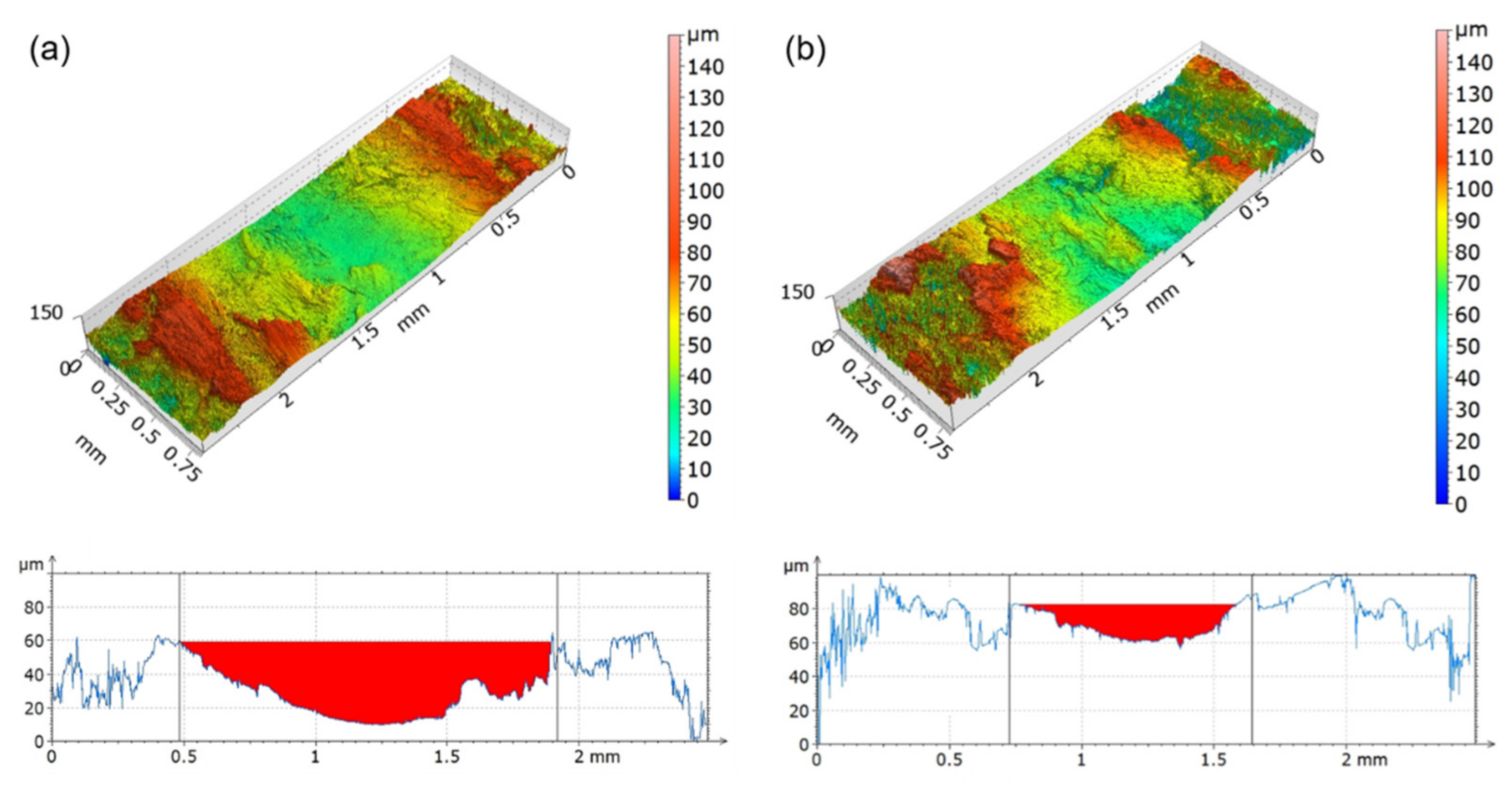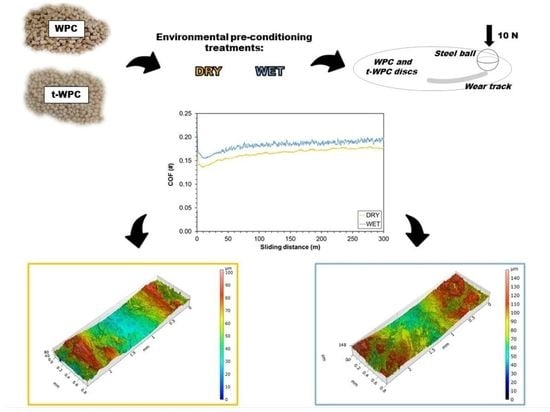Tribological Behavior of a Rubber-Toughened Wood Polymer Composite
Abstract
:1. Introduction
2. Experimental Procedures
2.1. Materials and Samples Preparation
2.2. Dynamic Mechanical Thermal Analyses
2.3. Hardness and Roughness
2.4. Environmental Pre-Treatments
2.5. Tribological Tests
2.6. Analyses of the Worn Surfaces
3. Results and Discussion
3.1. Hardness and Roughness
3.2. Dynamic Mechanical Thermal Analyses (DMTA)
3.3. Analysis of the Worn Surfaces
3.4. Profilometric Analysis
3.5. Weight Loss and Wear Rate
3.6. Friction Coefficient
3.7. Wear Mechanisms
4. Conclusions
Author Contributions
Funding
Institutional Review Board Statement
Informed Consent Statement
Data Availability Statement
Acknowledgments
Conflicts of Interest
References
- Adekomaya, O.; Jamiru, T.; Sadiku, R.; Huan, Z. A review on the sustainability of natural fiber in matrix reinforcement—A practical perspective. J. Reinf. Plast. Compos. 2016, 35, 3–7. [Google Scholar] [CrossRef] [Green Version]
- Kumar, V.; Tyagi, L.; Sinha, S. Wood flour–reinforced plastic composites: A review. Rev. Chem. Eng. 2011, 27, 235–264. [Google Scholar] [CrossRef]
- Mazzanti, V.; Mollica, F. A Review of Wood Polymer Composites Rheology and Its Implications for Processing. Polymers 2020, 12, 2304. [Google Scholar] [CrossRef]
- Santoni, A.; Bonfiglio, P.; Fausti, P.; Marescotti, C.; Mazzanti, V.; Pompoli, F. Characterization and Vibro-Acoustic Modeling of Wood Composite Panels. Materials 2020, 13, 1897. [Google Scholar] [CrossRef] [PubMed] [Green Version]
- Ashori, A. Wood–plastic composites as promising green-composites for automotive industries! Bioresour. Technol. 2008, 99, 4661–4667. [Google Scholar] [CrossRef] [PubMed]
- Pickering, K.L.; Efendy, M.G.A.; Le, T.M. A review of recent developments in natural fibre composites and their mechanical performance. Compos. Part A Appl. Sci. Manuf. 2016, 83, 98–112. [Google Scholar] [CrossRef] [Green Version]
- Sobczak, L.; Lang, R.W.; Haider, A. Polypropylene composites with natural fibers and wood—General mechanical property profiles. Compos. Sci. Technol. 2012, 72, 550–557. [Google Scholar] [CrossRef]
- Fortini, A.; Mazzanti, V. Combined effect of water uptake and temperature on wood polymer composites. J. Appl. Polym. Sci. 2018, 135, 46674. [Google Scholar] [CrossRef]
- Saw, S.K.; Purwar, R.; Nandy, S.; Ghose, J.; Sarkhel, G. Fabrication, Characterization, and Evaluation of Luffa cylindrica Fiber Reinforced Epoxy Composites. BioResources 2013, 8, 4805–4826. [Google Scholar] [CrossRef] [Green Version]
- Akil, H.M.; Santulli, C.; Sarasini, F.; Tirillò, J.; Valente, T. Environmental effects on the mechanical behaviour of pultruded jute/glass fibre-reinforced polyester hybrid composites. Compos. Sci. Technol. 2014, 94, 62–70. [Google Scholar] [CrossRef]
- Sergi, C.; Tirillò, J.; Seghini, M.C.; Sarasini, F.; Fiore, V.; Scalici, T. Durability of Basalt/Hemp Hybrid Thermoplastic Composites. Polymers 2019, 11, 603. [Google Scholar] [CrossRef] [PubMed] [Green Version]
- Oksman, K.; Clemons, C. Mechanical properties and morphology of impact modified polypropylene-wood flour composites. J. Appl. Polym. Sci. 1998, 67, 1503–1513. [Google Scholar] [CrossRef]
- Bledzki, A.K.; Faruk, O. Wood fibre reinforced polypropylene composites: Effect of fibre geometry and coupling agent on physico-mechanical properties. Appl. Compos. Mater. 2003, 10, 365–379. [Google Scholar] [CrossRef]
- Febraianto, F.; Hidayat, W.; Wistara, I.N.J.; Park, S.H.; Jang, J.; Lee, S.; Teramoto, Y.; Kondo, T.; Kim, N. Influence of Impact Modifier–Coupling agent Combination on Mechanical Properties of Wood Flour–Reinforced Polypropylene Composit. J. Fac. Agric. Kyushu Univ. 2017, 62, 445–450. [Google Scholar] [CrossRef]
- Mazzanti, V.; Salzano de Luna, M.; Pariante, R.; Mollica, F.; Filippone, G. Natural fiber-induced degradation in PLA-hemp biocomposites in the molten state. Compos. Part A Appl. Sci. Manuf. 2020, 137, 105990. [Google Scholar] [CrossRef]
- Mazzanti, V.; Cavalcoli, V.; Balbo, A.; Mollica, F. Hygrothermal degradation effects on a rubber toughened WPC. Mater. Today Proc. 2020, 31, S209–S212. [Google Scholar] [CrossRef]
- Pukánszky, B.; Tüdős, F.; Kolařik, J.; Lednický, F. Ternary composites of polypropylene, elastomer, and filler: Analysis of phase structure formation. Polym. Compos. 1990, 11, 98–104. [Google Scholar] [CrossRef]
- Vardai, R.; Lummerstorfer, T.; Pretschuh, C.; Jerabek, M.; Gahleitner, M.; Pukanszky, B.; Renner, K. Impact modification of PP/wood composites: A new approach using hybrid fibers. Express Polym. Lett. 2019, 13, 223–234. [Google Scholar] [CrossRef]
- Keledi, G.; Sudar, A.; Burgstaller, C.; Renner, K.; Moczo, J.; Pukanszky, B. Tensile and impact properties of three-component PP/wood/elastomer composites. Express Polym. Lett. 2012, 6, 224–236. [Google Scholar] [CrossRef]
- Sudár, A.; Renner, K.; Móczó, J.; Lummerstorfer, T.; Burgstaller, C.; Jerabek, M.; Gahleitner, M.; Doshev, P.; Pukánszky, B. Fracture resistance of hybrid PP/elastomer/wood composites. Compos. Struct. 2016, 141, 146–154. [Google Scholar] [CrossRef] [Green Version]
- Sudár, A.; Burgstaller, C.; Renner, K.; Móczó, J.; Pukánszky, B. Wood fiber reinforced multicomponent, multiphase PP composites: Structure, properties, failure mechanism. Compos. Sci. Technol. 2014, 103, 106–112. [Google Scholar] [CrossRef] [Green Version]
- Clemons, C. Elastomer modified polypropylene–polyethylene blends as matrices for wood flour–plastic composites. Compos. Part A Appl. Sci. Manuf. 2010, 41, 1559–1569. [Google Scholar] [CrossRef]
- Meekum, U.; Khongrit, A. Toughening of Wood-plastic Composites Based on Silane/Peroxide Macro Crosslink Poly(propylene) Systems. BioResources 2018, 13, 1678–1695. [Google Scholar] [CrossRef]
- Kakroodi, A.R.; Leduc, S.; González-Núñez, R.; Rodrigue, D. Mechanical Properties of Recycled Polypropylene/SBR Rubber Crumbs Blends Reinforced by Birch Wood Flour. Polym. Polym. Compos. 2012, 20, 439–444. [Google Scholar] [CrossRef]
- Kazemi, Y.; Cloutier, A.; Rodrigue, D. Mechanical and morphological properties of wood plastic composites based on municipal plastic waste. Polym. Compos. 2013, 34, 487–493. [Google Scholar] [CrossRef]
- Sombatsompop, N.; Yotinwattanakumtorn, C.; Thongpin, C. Influence of type and concentration of maleic anhydride grafted polypropylene and impact modifiers on mechanical properties of PP/wood sawdust composites. J. Appl. Polym. Sci. 2005, 97, 475–484. [Google Scholar] [CrossRef]
- Sharma, R.; Maiti, S.N. Effects of crystallinity of polypropylene (PP) on the mechanical properties of PP/styrene-ethylene-butylene-styrene-g-maleic anhydride (SEBS-g-MA)/teak wood flour (TWF) composites. Polym. Bull. 2015, 72, 627–643. [Google Scholar] [CrossRef]
- Vinayagamoorthy, R. Friction and wear characteristics of fibre-reinforced plastic composites. J. Thermoplast. Compos. Mater. 2020, 33, 828–850. [Google Scholar] [CrossRef]
- Vedrtnam, A.; Kumar, S.; Chaturvedi, S. Experimental study on mechanical behavior, biodegradability, and resistance to natural weathering and ultraviolet radiation of wood-plastic composites. Compos. Part B Eng. 2019, 176, 107282. [Google Scholar] [CrossRef]
- Chandgude, S.; Salunkhe, S. Biofiber-reinforced polymeric hybrid composites: An overview on mechanical and tribological performance. Polym. Compos. 2020, 41, 3908–3939. [Google Scholar] [CrossRef]
- Sheykh, M.J.; Tarmian, A.; Doosthoseini, K.; Abdulkhani, A. Wear resistance and friction coefficient of nano-SiO2 and ash-filled HDPE/lignocellulosic fiber composites. Polym. Bull. 2017, 74, 4537–4547. [Google Scholar] [CrossRef]
- Jiang, L.; He, C.; Fu, J.; Chen, D. Wear behavior of wood–plastic composites in alternate simulated sea water and acid rain corrosion conditions. Polym. Test. 2017, 63, 236–243. [Google Scholar] [CrossRef]
- Balogun, O.P.; Alaneme, K.K.; Adediran, A.A.; Omotoyinbo, J.A. Mechanical properties and friction coefficient of hybrid polypropylene Entada mannii composites. Mater. Res. Express 2020, 7, 115301. [Google Scholar] [CrossRef]
- Bajpai, P.K.; Singh, I.; Madaan, J. Tribological behavior of natural fiber reinforced PLA composites. Wear 2013, 297, 829–840. [Google Scholar] [CrossRef]
- Jeamtrakull, S.; Kositchaiyong, A.; Markpin, T.; Rosarpitak, V.; Sombatsompop, N. Effects of wood constituents and content, and glass fiber reinforcement on wear behavior of wood/PVC composites. Compos. Part B Eng. 2012, 43, 2721–2729. [Google Scholar] [CrossRef]
- Ibrahim, M.A.; Hirayama, T.; Khalaf, D. An investigation into the tribological properties of wood flour reinforced polypropylene composites. Mater. Res. Express 2019, 7, 015313. [Google Scholar] [CrossRef] [Green Version]
- Savaş, S.; Gurbanov, N.; Doğan, M. Effect of fiber type, fiber content, and compatibilizer on two-body abrasive wear performance of HDPE matrix composites. J. Compos. Mater. 2019, 53, 2743–2760. [Google Scholar] [CrossRef]
- Aurrekoetxea, J.; Sarrionandia, M.; Gómez, X. Effects of microstructure on wear behaviour of wood reinforced polypropylene composite. Wear 2008, 265, 606–611. [Google Scholar] [CrossRef]
- Chand, N.; Dwivedi, U.K. Effect of coupling agent on abrasive wear behaviour of chopped jute fibre-reinforced polypropylene composites. Wear 2006, 261, 1057–1063. [Google Scholar] [CrossRef]
- Goriparthi, B.K.; Suman, K.N.S.; Mohan Rao, N. Effect of fiber surface treatments on mechanical and abrasive wear performance of polylactide/jute composites. Compos. Part A Appl. Sci. Manuf. 2012, 43, 1800–1808. [Google Scholar] [CrossRef]
- Mazzanti, V.; Mollica, F.; El Kissi, N. Rheological and mechanical characterization of polypropylene-based wood plastic composites. Polym. Compos. 2016, 37, 3460–3473. [Google Scholar] [CrossRef]
- Mazzanti, V.; Malagutti, L.; Santoni, A.; Sbardella, F.; Calzolari, A.; Sarasini, F.; Mollica, F. Correlation between mechanical properties and processing conditions in rubber-toughened wood polymer composites. Polymers 2020, 12, 1170. [Google Scholar] [CrossRef] [PubMed]
- Leblanc, J.L. Nonlinear viscoelastic characterization of molten thermoplastic vulcanizates (TPV) through large amplitude harmonic experiments. Rheol. Acta 2007, 46, 1013–1027. [Google Scholar] [CrossRef]
- Mazzanti, V.; Mollica, F. Pressure dependent wall slip of wood flour filled polymer melts. J. Nonnewton. Fluid Mech. 2017, 247, 178–187. [Google Scholar] [CrossRef]








| Material | Wood (wt %) | PP (wt %) | TPV (wt %) | Theoretical Density (g/cm3) |
|---|---|---|---|---|
| WPC | 50 | 50 | 0 | 1.07 |
| t-WPC | 50 | 30 | 20 | 1.09 |
| Material | Ra (µm) | Hardness (Shore D) |
|---|---|---|
| WPC | 13.9 ± 2.2 | 28.9 ± 1.0 |
| t-WPC | 17.6 ± 3.0 | 24.7 ± 0.9 |
| Material | Pre-Treatment | Width (µm) | Depth (µm) |
|---|---|---|---|
| WPC | DRY | 0.9 ± 0.2 | 26.6 ± 9.5 |
| WET | 1.3 ± 0.3 | 37.8 ± 18.9 | |
| t-WPC | DRY | 1.8 ± 0.5 | 49.9 ± 5.5 |
| WET | 1.7 ± 0.6 | 48.6 ± 6.5 |
| Material | Pre-Treatment | Sliding Distances (m) | Weight Loss (mg) | WR (mm3/Nm) |
|---|---|---|---|---|
| WPC | DRY | 300 | 0.39 ± 0.03 | 0.004 |
| WET | 300 | 23.5 ± 3.6 | 0.094 | |
| DRY | 600 | 1.65 ± 0.1 | 0.002 | |
| WET | 600 | 40.4 ± 0.8 | 0.043 | |
| t-WPC | DRY | 300 | 0.71 ± 0.2 | 0.003 |
| WET | 300 | 12.3 ± 3.0 | 0.084 | |
| DRY | 600 | 1.1 ± 0.2 | 0.002 | |
| WET | 600 | 26.1 ± 0.3 | 0.038 |
Publisher’s Note: MDPI stays neutral with regard to jurisdictional claims in published maps and institutional affiliations. |
© 2021 by the authors. Licensee MDPI, Basel, Switzerland. This article is an open access article distributed under the terms and conditions of the Creative Commons Attribution (CC BY) license (https://creativecommons.org/licenses/by/4.0/).
Share and Cite
Mazzanti, V.; Fortini, A.; Malagutti, L.; Ronconi, G.; Mollica, F. Tribological Behavior of a Rubber-Toughened Wood Polymer Composite. Polymers 2021, 13, 2055. https://doi.org/10.3390/polym13132055
Mazzanti V, Fortini A, Malagutti L, Ronconi G, Mollica F. Tribological Behavior of a Rubber-Toughened Wood Polymer Composite. Polymers. 2021; 13(13):2055. https://doi.org/10.3390/polym13132055
Chicago/Turabian StyleMazzanti, Valentina, Annalisa Fortini, Lorenzo Malagutti, Giulia Ronconi, and Francesco Mollica. 2021. "Tribological Behavior of a Rubber-Toughened Wood Polymer Composite" Polymers 13, no. 13: 2055. https://doi.org/10.3390/polym13132055








